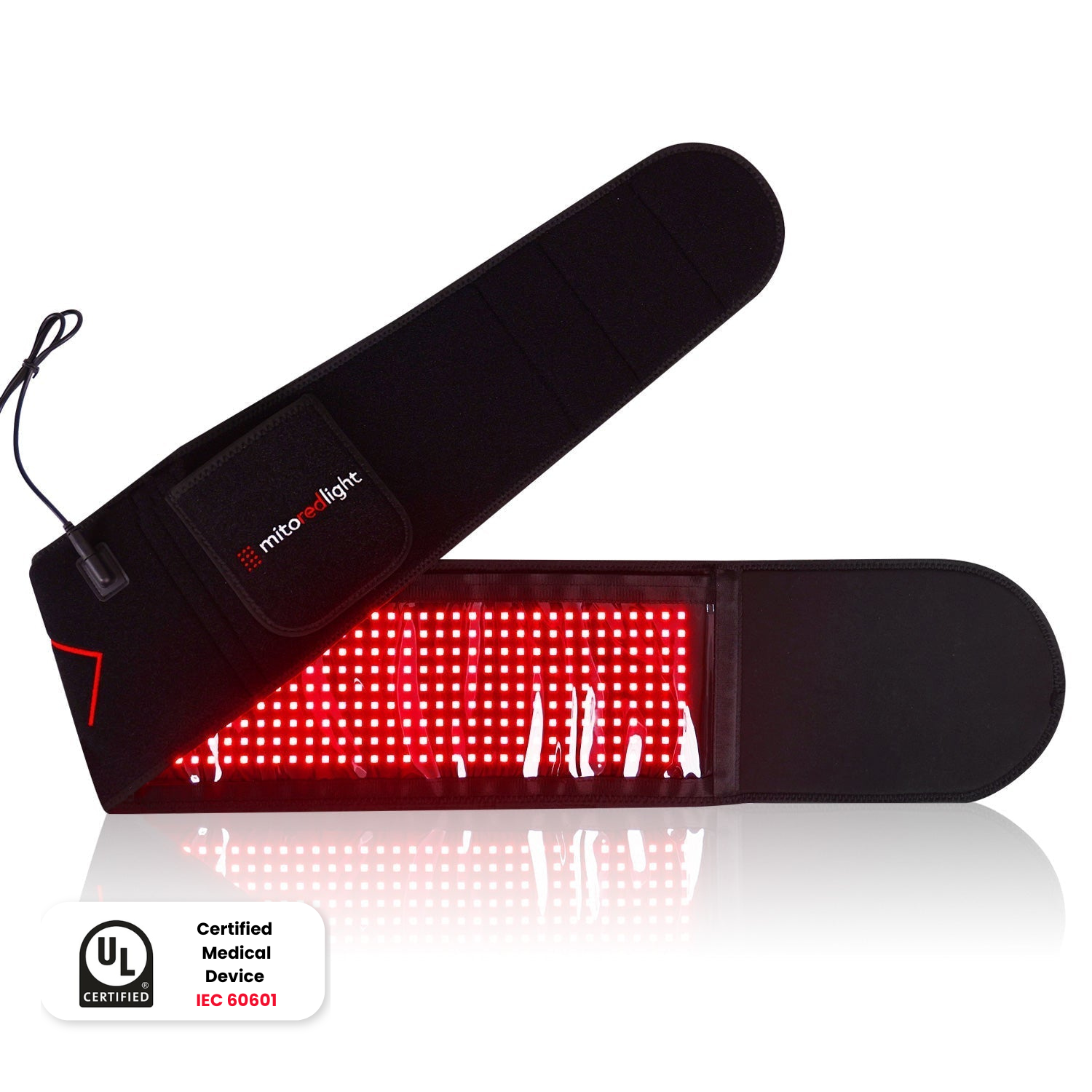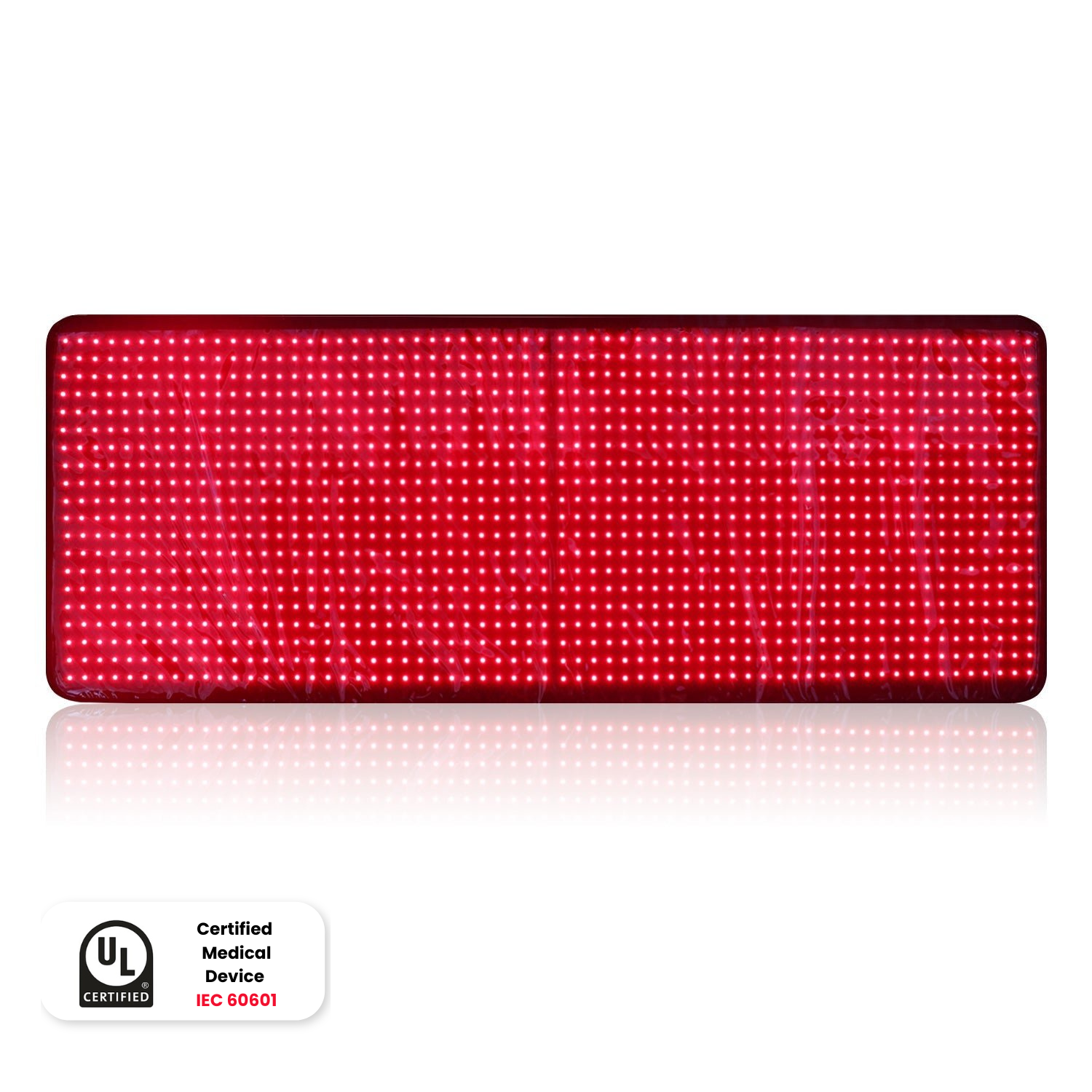DISCLAIMER: Mito Red Light devices are Class II wellness devices aimed at affecting the body through topical heating and supporting cellular function. The information provided in this article and on this site is for educational purposes only and is not intended to imply effectiveness of Mito Red Light devices for any specific application. The information provided in this article and on this site is not intended to diagnose, treat, cure, or prevent any disease, is not a substitute for consultation with a licensed medical provider and should not be construed as medical advice. Click here to read our article on potential contraindications of red light therapy..
Red light therapy is a newer way of improving multiple aspects of health that has seen a recent growth in its popularity. Red light therapy is used for multiple purposes, including managing chronic pain, improving skin health and appearance, optimizing workout performance and recovery, and many other health applications.
As red light therapy is being used by more and more people, it is important for those who are new to using it to understand how it works. Some people look at the red light therapy panels that are being sold and wonder why they would need a red light panel instead of just using their own source of red light. While it might seem like using your own red light source would be just as good as a professional-grade red light therapy panel, there are multiple considerations that are important for the source that you use for red light therapy.
What is Red Light Therapy?
Before anyone can understand what the best sources for red light therapy are, they will first need to know the basics of what red light therapy is and how it works. Red light therapy first gained attention as a potential way of improving people’s health during NASA research in the 1990s. While conducting experiments on plant growth, NASA researchers accidentally discovered that prolonged exposure to red lights improved the speed of wound healing.
Since NASA's initial discovery, red light research and use has grown tremendously, with red light therapy now being used to improve sleep quality, help cognitive function, improve circulation, and achieve many other health benefits.
How Does Red Light Therapy Work?
Research into red light therapy and how it works is still an ongoing area of scientific study, however, existing research shows that many of the positive effects of red light therapy are due to how light interacts with mitochondria, a tiny organ found in each cell of your body. Mitochondria are responsible for many functions in cells, but most importantly provide cells with energy.
Light Affects Biological Functions
Many molecules or cells in the body are sensitive to particular wavelengths of light. The best example of this phenomena are cone cells in the retina. Three different types of cone cells are all activated by specific wavelengths of light, creating the ability for the brain to perceive color.
Molecules can also absorb specific wavelengths of light, with the light in some cases actually changing the molecule. An example of this is how a molecule call bilirubin is affected by ultraviolet light. When exposed to specific wavelengths of ultraviolet light, bilirubin will break down in the body into other molecules. This effect is used to provide medical treatment to some newborns who are not able to breakdown bilirubin. A build up of bilirubin can lead to brain damage, and ultraviolet light therapy is used to breakdown bilirubin in newborns who cannot do so themselves.
The specific target of red light therapy is thought to be a molecule in the mitochondria called cytochrome C oxidase. This molecule is sensitive to specific wavelengths of red and near-infrared light and plays a vital role in producing energy in the cells. Stimulation of this molecule has been shown to increase energy levels and promote multiple healthy processes in the body.
The Biological Behavior of Red Light
Light is a wave that can have many different wavelengths. For visible light, shorter wavelengths have higher energy and are violet or blue colored. Longer wavelengths have lower energy and are orange or red colored. Red light therapy uses only the longer, lower energy wavelengths, as these wavelengths are the ones absorbed by cytochrome C oxidase.
The longer red wavelengths of light penetrate more deeply into the body than shorter wavelengths, such as violet or ultraviolet light. This enables them to reach deeper tissues that sit underneath the skin. Because it is lower energy light, red light also does not carry the same risks for damage or cancer that ultraviolet light does.
Red Light Source Considerations
As people use red light, one question people often have is why they should invest in a professional-grade red light panel instead of just using their own red light sources. There are several different reasons why red light panels are the best way to use red light therapy.
Wavelength
The wavelengths of red light that actually have been shown to affect mitochondria are very specific. Not any wavelength of light, or even any wavelength of red light will do.
Light from many sources, such as incandescent bulbs, is made up of many, many different wavelengths of light. These wavelengths of light combine to make the light appear a white or off-white color. If you were to place a transparent, red cover over an ordinary light bulb, the light will appear red. This is because all of the non-red wavelengths are filtered out, leaving only the red wavelengths of light. You would also notice that the light is much darker with this filter; this is due to the fact that red wavelengths only make up a small portion of the light.
While most light sources are made up of many different wavelengths, advances in light-emitting diode (LED) lighting technology has enabled the creation of light sources that can produce only one wavelength of light. This allows for all of the power used by a device to be directed into making a single, specific wavelength of light.
With red light therapy, there are only a few wavelengths of light that are thought to be useful. Professional red light therapy panels can produce the correct mix of wavelengths needed to optimize the effectiveness of red light therapy.
Intensity
When using red light therapy, the intensity of the red light is very important. The greater the intensity of the light, the more effect it will have. Many ordinary light sources are not capable of producing the intensity of red light needed to actually provide any kind of meaningful benefit.
The energy of light is related to its wavelength, not to its intensity. This is somewhat counterintuitive, but is actually a foundational concept of quantum physics and was discovered by Albert Einstein. What this means for red light therapy, is that very intense levels of red light therapy can be used without a high risk of damaging the cells or creating other types of injuries.
The one most likely harmful effect of high intensity light is heat caused by the light source itself. The use of a professional-grade light source can enable the production of high-intensity red light while reducing the heat generated while producing the light.
The main intensity-related benefit of professional-grade red light therapy panels is that they can produce red light at intensities that are likely to actually have a meaningful effect on the body. Ordinary sources of red light may still have some kind of positive impact, but it may not be nearly as noticeable or helpful as high-quality red light therapy panels.
Flicker
Almost every light source in the world today uses a type of electrical current called alternating current (AC) electricity. AC electricity pushes electrical current back and forth rapidly though light production sources many times per second. This creates a flicker to lights that is normally not perceptible unless the flicker occurs at a very slow rate.
The flicker all sources experience can have potentially harmful effects in some cases and can reduce the overall intensity of the light that you receive from a source. Red light panels that are specifically designed for red light therapy will normally reduce the amount of flicker that occurs, helping to improve how effective the therapy is while reducing the risks that flicker can create.
Area of Exposure
Another vital concept to consider when selecting a form of red light therapy is the area that the light source covers. The intensity of light reduces considerably the farther that it gets from its sources. When using a single light source, this means that the areas of the body closest to the source will get the most benefit, while areas of the body further from the source will get significantly less benefit.
Red light panels designed specifically for red light therapy solve this problem by creating a panel that has multiple light sources, providing an even exposure to red light over a larger area. Fully body panels can even allow red light to evenly cover the entire body at once.
Where to Get the Best Red Light Panels
There are many types of red light panels that are offered for sale today, some from highly reputable, well established businesses and some from businesses that cut corners and misrepresent how their panels perform.
There are several ways to ensure that you are getting red light panels from reputable sources. These include:
- Reviews - The number and quality of reviews can be a good indicator of the quality of the products that a business provides.
- Time in Business - While red light therapy is a newer technology, any business that has existed for two years or less has not yet proven themselves in this field and extra care should be taken when researching these businesses.
- Information Directly from the Business - Some businesses providing red light therapy products can be unethical and misrepresent their competitors. It is always important to ensure that what one business says about another business’s products is true, and not to just take their word for it.
- Compare Specifications - Once you have established that a business selling red light therapy panels is reputable, you will want to understand the specifications of their different products and compare these specifications with those provided by other businesses.
Mito Red Light
Many of our products have five star reviews by hundreds of customers. We have been in business for several years and provide some of the best red light therapy panels available today. We welcome you to review our selection of high-quality products or to contact one of our expert representatives at +1 866-861-6486 to learn more about us and the products that we provide.
Related Articles:
- What Is Red and Near Infrared (NIR) Light Therapy?
- Red Light Therapy Buyer’s Guide
- Everything You Need to Know About Red Light Therapy and SKIN
DISCLAIMER: Mito Red Light devices are Class II wellness devices aimed at affecting the body through topical heating and supporting cellular function. The information provided in this article and on this site is for educational purposes only and is not intended to imply effectiveness of Mito Red Light devices for any specific application. The information provided in this article and on this site is not intended to diagnose, treat, cure, or prevent any disease, is not a substitute for consultation with a licensed medical provider and should not be construed as medical advice. Click here to read our article on potential contraindications of red light therapy..































